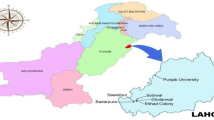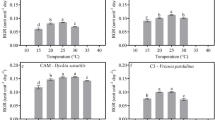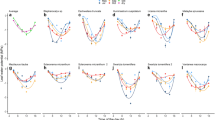Abstract
Key message
Rhododendron × pulchrum avoided air pollution by adjusting its stomatal density, while Ginkgo biloba tolerated air pollution via a small stomatal density and high mesophyll thickness.
Abstract
Information on the physiological mechanisms underlying species-specific photosynthetic responses to ambient air pollution is essential for enhancing the multiple services provided by urban trees. We conducted an on-site investigation of Rhododendron × pulchrum and Ginkgo biloba, which are the most common shrub and tall roadside tree used in Japan, in order to clarify their photosynthetic responses at sites with different air pollution levels in Kyoto city, Japan. The shrub tree R. × pulchrum and tall tree G. biloba exhibited contrasting responses to air pollution mainly from automobile exhaust gas. R. × pulchrum had a lower photosynthetic rate and stomatal conductance at high-pollution sites than at low-pollution sites, while no reductions were observed at high-pollution sites for G. biloba. The stomatal density of R. × pulchrum negatively correlated with atmospheric nitrogen oxides (NO and NO2) concentrations. R. × pulchrum avoided the effects of air pollution by reducing stomatal density at high-pollution sites at the expense of reducing CO2 uptake, while G. biloba appeared to have the ability to tolerate high air pollution levels by reducing the pollution load per mesophyll cell surface area with a low stomatal density and large mesophyll thickness. In conclusion, R. × pulchrum and G. biloba both acclimate to urban environments through an avoidance or tolerance strategy for air pollution by regulating stomatal and/or mesophyll morphologies.






Similar content being viewed by others
References
Alves ES, Moura BB, Domingos M (2008) Structural analysis of Tillandsia usneoides L. exposed to air pollutants in São Paulo City-Brazil. Water Air Soil Pollut 189:61–68. https://doi.org/10.1007/s11270-007-9555-1
Bassuk N, Curtis DF, Marranca BZ, Neal B (2009) Recommended urban trees: site assessment and tree selection for stress tolerance. Urban Horticulture Institute, Department Of Horticulture, Cornell University, Ithaca, New York
Brunner I, Herzog C, Dawes MA, Arend M, Sperisen C (2015) How tree roots respond to drought. Front Plant Sci 6:1–16. https://doi.org/10.3389/fpls.2015.00547
Carriquí M, Cabrera HM, Conesa M, Coopman RE, Douthe C, Gago J, Gallé A, Galmés J, Ribas-Carbo M, Tomás M, Flexas J (2015) Diffusional limitations explain the lower photosynthetic capacity of ferns as compared with angiosperms in a common garden study. Plant Cell Environ 38:448–460. https://doi.org/10.1111/pce.12402
Cataldo DA, Maroon M, Schrader LE, Youngs VL (1975) Rapid colorimetric determination of nitrate in plant tissue by nitration of salicylic acid. Commun Soil Sci Plant Anal 6:71–80. https://doi.org/10.1080/00103627509366547
Chaparro-Suarez IG, Meixner FX, Kesselmeier J (2011) Nitrogen dioxide (NO2) uptake by vegetation controlled by atmospheric concentrations and plant stomatal aperture. Atmos Environ 45:5742–5750. https://doi.org/10.1016/j.atmosenv.2011.07.021
Cregg BM, Dix ME (2001) Tree moisture stress and insect damage in urban areas in relation to heat island effects. J Arboric 27:8–17
Dhir B (2016) Air pollutants ad photosynthetic efficiency of plants. In: Kulshrestha U, Saxena P (eds) Plant responses to air pollution. Springer, Singapore, pp 71–84
Dineva SB (2004) Comparative studies of the leaf morphology and structure of white ash Fraxinus americana L. and London plane tree Platanus acerifolia Willd growing in polluted area. Dendrobiology 52:3–8
Ennajeh M, Vadel AM, Cochard H, Khemira H (2010) Comparative impacts of water stress on the leaf anatomy of a drought-resistant and a drought-sensitive olive cultivar. J Hortic Biotechnol 85:289–294. https://doi.org/10.1080/14620316.2010.11512670
Ethier GJ, Livingston NJ (2004) On the need to incorporate sensitivity to CO2 transfer conductance into the Farquhar-von Caemmerer-Berry leaf photosynthesis model. Plant Cell Environ 27:137–153. https://doi.org/10.1111/j.1365-3040.2004.01140.x
Ethier GJ, Livingston NJ, Harrison DL, Black TA, Moran JA (2006) Low stomatal and internal conductance to CO2 versus Rubisco deactivation as determinants of the photosynthetic decline of ageing evergreen leaves. Plant Cell Environ 29:2168–2184. https://doi.org/10.1111/j.1365-3040.2006.01590.x
Franks PJ, Beerling DJ (2009) Maximum leaf conductance driven by CO2 effects on stomatal size and density over geologic time. Proc Natl Acad Sci 106:10343–10347. https://doi.org/10.1073/pnas.0904209106
Grote R, Samson R, Alonso R, Amorim JH, Cariñanos P, Churkina G, Fares S, Thiec DL, Niinemets Ü, Mikkelsen TN, Paoletti E, Tiwary A, Calfapietra C (2016) Functional traits of urban trees: air pollution mitigation potential. Front Ecol Environ 14:543–550. https://doi.org/10.1002/fee.1426
Hanba YT, Kogami H, Terashima I (2002) The effect of growth irradiance on leaf anatomy and photosynthesis in Acer species differing in light adaptation. Plant Cell Environ 25:1021–1030. https://doi.org/10.1046/j.1365-3040.2002.00881.x
Handa M, Iizuka Y, Fujiwara N (1997) Ginkgo landscapes. In: Hori T, Ridge RW, Tulecke W, Del Tredici P, Tremouillaux-Guiller J, Tobe H (eds) Ginkgo Biloba—a global treasure: from biology to medicine. Springer, Tokyo, pp 259–283
Heber U, Kaiser W, Luwe M, Kindermann G, Veljovic-Javonovic S, Yin Z, Pfanz H, Slovik S (1995) Air pollution, photosynthesis and forest decline: interactions and consequences. In: Schulze E-D, Caldwell MM (eds) Ecophysiology of photosynthesis. Springer, Berlin, pp 279–296
Hirano T, Kiyota M, Aiga I (1996) Vegetation in Sakai City, Osaka, as a sink of air pollutants. Bull Univ Osaka Prefect Ser B Agric life Sci 48:55–64
Jochner S, Markevych I, Beck I, Traidl-Hoffmann C, Heinrich J, Menzel A (2015) The effects of short- and long-term air pollutants on plant phenology and leaf characteristics. Environ Pollut 206:382–389. https://doi.org/10.1016/j.envpol.2015.07.040
Kagotani Y, Fujino K, Kazama T, Hanba YT (2013) Leaf carbon isotope ratio and water use efficiency of urban roadside trees in summer in Kyoto city. Ecol Res 28:725–734. https://doi.org/10.1007/s11284-013-1056-7
Kagotani Y, Nishida K, Kiyomizu T, Sasaki K, Kume A, Hanba YT (2016) Photosynthetic responses to soil water stress in summer in two Japanese urban landscape tree species (Ginkgo biloba and Prunus yedoensis): effects of pruning mulch and irrigation management. Trees Struct Funct 30:697–708. https://doi.org/10.1007/s00468-015-1312-2
Kardel F, Wuyts K, Babanezhad M, Vitharana UWA, Wuytack T, Potters G, Samson R (2010) Assessing urban habitat quality based on specific leaf area and stomatal characteristics of Plantago lanceolata L. Environ Pollut 158:788–794. https://doi.org/10.1016/j.envpol.2009.10.006
Kawase M, Hanba YT, Katsuhara M (2013) The photosynthetic response of tobacco plants overexpressing ice plant aquaporin McMIPB to a soil water deficit and high vapor pressure deficit. J Plant Res 126:517–527. https://doi.org/10.1007/s10265-013-0548-4
Kim YS, Lee JK, Chung GC (1997) Tolerance and susceptibility of Ginkgo to air pollution. In: Hori T, Ridge RW, Tulecke W, Del Tredici P, Trémouillaux-Guiller J, Tobe H (eds) Ginkgo Biloba—a global treasure: from biology to medicine. Springer, Tokyo, pp 233–242
Kogami H, Kogami H, Hanba YT, Hanba YT, Kibe T, Kibe T, Terashima I, Terashima I, Masuzawa T, Masuzawa T (2001) CO2 transfer conductance, leaf structure and carbon isotope composition of Polygonum cuspidatum leaves from low and high altitudes. Plant Cell Environ 24:529–538. https://doi.org/10.1046/j.1365-3040.2001.00696.x
Kume A, Tsuboi N, Satomura T, Suzuki M, Chiwa M, Nakane K, Sakurai N, Horikoshi T, Sakugawa H (2000) Physiological characteristics of Japanese red pine, Pinus densiflora Sieb. et Zucc., in declined forests at Mt. Gokurakuji in Hiroshima Prefecture, Japan. Trees 14:305–311. https://doi.org/10.1007/PL00009772
Kume A, Arakaki T, Tsuboi N, Suzuki M, Kuramoto D, Nakane K, Sakugawa H (2001) Harmful effects of radicals generated in polluted dew on the needles of Japanese Red Pine (Pinus densiflora). New Phytol 152:53–58. https://doi.org/10.1046/j.0028-646x.2001.00236.x
Kume A, Hanba YT, Nakane K, Sakurai N, Sakugawa H (2006) Seasonal changes in needle water content and needle ABA concentration of Japanese red pine, Pinus densiflora Sieb. et Zucc., in declining forests on Mt. Gokurakuji, Hiroshima Prefecture, Japan. J Plant Res 119:231–238. https://doi.org/10.1007/s10265-006-0265-3
Kurihara M, Takeda Y, Kubota S (2014) The roadside trees of Japan VIII. International Research Division, Ministry of Land, Infrastructure, Transport and Tourism Japan, Tokyo
Lambers H, Chapin FS III, Pons TL (2008) Plant water relations, 2nd edn. Springer, New York
Larcher W (2003) Plant physiological ecology. Springer, Berlin
Livesley SJ, McPherson GM, Calfapietra C (2016) The urban forest and ecosystem services: impacts on urban water, heat, and pollution cycles at the tree, street, and city scale. J Environ Qual 45:119. https://doi.org/10.2134/jeq2015.11.0567
Maier-Maercker U (1999) Predisposition of trees to drought stress by ozone. Tree Physiol 19:71–78. https://doi.org/10.1093/treephys/19.2.71
Nowak DJ, Hirabayashi S, Bodine A, Greenfield E (2014) Tree and forest effects on air quality and human health in the United States. Environ Pollut 193:119–129. https://doi.org/10.1016/j.envpol.2014.05.028
Ögren E, Evans JR (1993) Photosynthetic light-response curves. Planta 189:182–190. https://doi.org/10.1007/BF00195075
Pal A, Kulshreshtha K, Ahmad KJ, Behl HM (2002) Do leaf surface characters play a role in plant resistance to auto-exhaust pollution? Flora Morphol Distrib Funct Ecol Plants 197:47–55. https://doi.org/10.1078/0367-2530-00014
Panek JA, Goldstein AH (2001) Response of stomatal conductance to drought in ponderosa pine: implications for carbon and ozone uptake. Tree Physiol 21:337–344. https://doi.org/10.1093/treephys/21.5.337
Paoletti E, Grulke NE (2005) Does living in elevated CO2 ameliorate tree response to ozone? A review on stomatal responses. Environ Pollut 137:483–493
Paoletti E, Grulke NE (2010) Ozone exposure and stomatal sluggishness in different plant physiognomic classes. Environ Pollut 158:2664–2671. https://doi.org/10.1016/j.envpol.2010.04.024
Paoletti E, Conese I, Bacci L (2014) Urban vegetation facing pollution and overheating. In: Freedman B (ed) Global environmental change. Springer, Berlin, pp 487–495
Peguero-Pina JJ, Sancho-Knapik D, Flexas J, Galmés J, Niinemets Ü, Gil-Pelegrín E (2016) Light acclimation of photosynthesis in two closely related firs (Abies pinsapo Boiss. and Abies alba Mill.): the role of leaf anatomy and mesophyll conductance to CO2. Tree Physiol 36:300–310. https://doi.org/10.1093/treephys/tpv114
Pourkhabbaz A, Rastin N, Olbrich A, Langenfeld-Heyser R, Polle A (2010) Influence of environmental pollution on leaf properties of urban plane trees, Platanus orientalis L. Bull Environ Contam Toxicol 85:251–255. https://doi.org/10.1007/s00128-010-0047-4
Rashidi F, Jalili A, Kafaki SB, Sagheb-Talebi K, Hodgson J (2012) Anatomical responses of leaves of Black Locust (Robinia pseudoacacia L.) to urban pollutant gases and climatic factors. Trees Struct Funct 26:363–375. https://doi.org/10.1007/s00468-011-0598-y
Sakugawa H, Matsuda T, Nakatani N (2011) Automobile exhaust gas as a source of aqueous phase OH radical in the atmosphere and its effects on physiological status of pine trees. Chemosphere 85:812–819. https://doi.org/10.1016/j.chemosphere.2011.06.079
Schneider CA, Rasband WS, Eliceiri KW (2012) NIH Image to ImageJ: 25 years of image analysis. Nat Methods 9:671–675
Smith BN, Mel Lytle C (1997) Air pollutants. In: Prasad MNV (ed) Plant ecophysiology. Wiley, New York, pp 375–392
Takagi M, Gyokusen K (2004) Light and atmospheric pollution affect photosynthesis of street trees in urban environments. Urb For Urb Green 2:167–171. https://doi.org/10.1078/1618-8667-00033
Takahashi M, Higaki A, Nohno M, Kamada M, Okamura Y, Matsui K, Kitani S, Morikawa H (2005) Differential assimilation of nitrogen dioxide by 70 taxa of roadside trees at an urban pollution level. Chemosphere 61:633–639. https://doi.org/10.1016/j.chemosphere.2005.03.033
Tayasu I, Hirasawa R, Ogawa NO, Ohkouchi N, Yamada K (2011) New organic reference materials for carbon- and nitrogen-stable isotope ratio measurements provided by Center for Ecological Research, Kyoto University, and Institute of Biogeosciences, Japan Agency for Marine-Earth Science and Technology. Limnology 12:261–266. https://doi.org/10.1007/s10201-011-0345-5
Terashima I, Hanba YT, Tholen D, Niinemets Ü (2011) Leaf functional anatomy in relation to photosynthesis. Plant Physiol 155:108–116. https://doi.org/10.1104/pp.110.165472
Tosens T, Nishida K, Gago J, Coopman RE, Cabrera M, Carriquí M, Laanisto L, Morales L, Nadal M, Rojas R, Talts E, Tomas M, Hanba Y, Niinemets Ü, Flexas J (2016) The photosynthetic capacity in 35 ferns and fern allies: mesophyll CO2 diffusion as a key trait. New Phytol 209:1576–1590. https://doi.org/10.1111/nph.13719
Vallano DM, Sparks JP (2008) Quantifying foliar uptake of gaseous nitrogen dioxide using enriched foliar δ15N values. New Phytol 177:946–955. https://doi.org/10.1111/j.1469-8137.2007.02311.x
Vardaka E, Cook CM, Lanaras T, Sgardelis SP, Pantis JD (1995) Effect of dust from a limestone quarry on the photosynthesis of Quercus coccifera, an evergreen Schlerophyllous shrub. Bull Environ Contam Toxicol 54:414–419. https://doi.org/10.1007/BF00195114
Vico G, Revelli R, Porporato A (2014) Ecohydrology of street trees: design and irrigation requirements for sustainable water use. Ecohydrology 7:508–523. https://doi.org/10.1002/eco.1369
Woo SY, Je SM (2006) Photosynthetic rates and antioxidant enzyme activity of Platanus occidentalis growing under two levels of air pollution along the streets of Seoul. J Plant Biol 49:315–319. https://doi.org/10.1007/BF03031162
Wuytack T, Samson R, Wuyts K, Adriaenssens S, Kardel F, Verheyen K (2013) Do leaf characteristics of white willow (Salix alba L.), Northern Red Oak (Quercus rubra L.), and scots pine (Pinus sylvestris L.) respond differently to ambient air pollution and other environmental stressors? Water Air Soil Pollut 224:1635–1649. https://doi.org/10.1007/s11270-013-1635-9
Yue B, Xue W, Xiong L, Yu X, Luo L, Cui K, Jin D, Xing Y, Zhang Q (2006) Genetic basis of drought resistance at reproductive stage in rice: separation of drought tolerance from drought avoidance. Genetics 172:1213–1228. https://doi.org/10.1534/genetics.105.045062
Acknowledgements
This work was supported by a Grant-in-Aid for Scientific Research (15K00566), the Sumitomo Foundation (103230), Adaptable & Seamless Technology Transfer Program through Target-driven R&D (AS262Z01258N), and Discretionary expense of the President of Kyoto Institute of Technology. The leaf stable carbon isotope ratio was measured at the Center for Ecological Research, Kyoto University and Research Institute for Humanity and Nature. We appreciate Drs. Ichiro Tayasu and Riyo Hirasawa for supporting the isotope measurements. We thank Drs Jiro Tatsumi and Etsu Yamada for supporting our research.
Author information
Authors and Affiliations
Corresponding author
Ethics declarations
Conflict of interest
The authors declare that they have no conflict of interest.
Additional information
Communicated by Kajimoto.
Electronic supplementary material
Below is the link to the electronic supplementary material.
Rights and permissions
About this article
Cite this article
Kiyomizu, T., Yamagishi, S., Kume, A. et al. Contrasting photosynthetic responses to ambient air pollution between the urban shrub Rhododendron × pulchrum and urban tall tree Ginkgo biloba in Kyoto city: stomatal and leaf mesophyll morpho-anatomies are key traits. Trees 33, 63–77 (2019). https://doi.org/10.1007/s00468-018-1759-z
Received:
Accepted:
Published:
Issue Date:
DOI: https://doi.org/10.1007/s00468-018-1759-z




